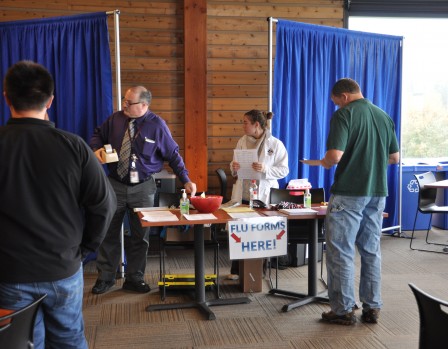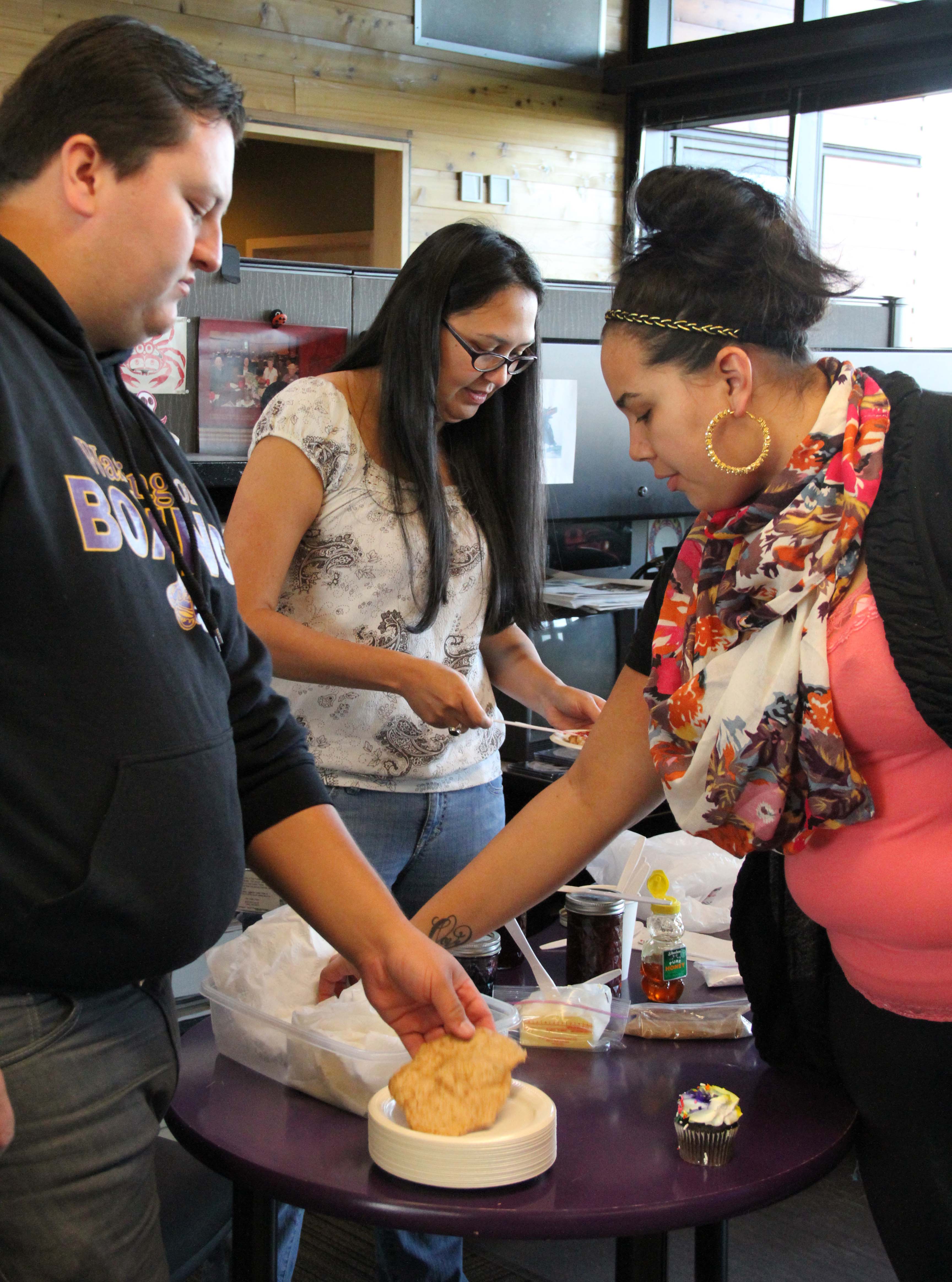Pet friends of Tulalip tribal members and employees get in the Halloween spirit.
syəcəb
Pet friends of Tulalip tribal members and employees get in the Halloween spirit.

By Monica Brown, Tulalip News Writer
TULALIP, Wash. – Flu season is here and if you want to prevent from getting the flu or contributing to spreading it, the flu vaccine is the way to go. Today, Oct. 22nd, from 12:00 to 3:00pm at the Tulalip Admin building, the Tulalip Pharmacy is issuing flu vaccines on the second floor in the lunch area. For non-tribal members please bring your medical insurance information.
The Center for Disease Control recommends that all those who are able to be vaccinated do so. Listed below is some information from the CDC about how the vaccine works and who should consider getting vaccinated.
How do flu vaccines work?
Flu vaccines cause antibodies to develop in the body about two weeks after vaccination. These antibodies provide protection against infection with the viruses that are in the vaccine.
The seasonal flu vaccine protects against the influenza viruses that research indicates will be most common during the upcoming season. Traditional flu vaccines (called trivalent vaccines) are made to protect against three flu viruses; an influenza A (H1N1) virus, an influenza A (H3N2) virus, and an influenza B virus. In addition, this season, there are flu vaccines made to protect against four flu viruses (called “quadrivalent” vaccines). These vaccines protect against the same viruses as the trivalent vaccine as well as an additional B virus.
While everyone should get a flu vaccine this season, it’s especially important for some people to get vaccinated.
Those people include the following:
Diabetes day at the Tulalip Health Clinic

By Andrew Gobin, Tulalip News
“Rather than making multiple appointments throughout the week, today we have made available every service for diabetes testing all at once,” said Bryan Cooper about the October 15th diabetes day at the Tulalip Karen I. Fryberg Health Clinic. A day meant to inform about the disease also offers tips on diabetes prevention, healthy living, and general nutrition.
Cooper, the medical director at the clinic, made key points as to why diabetes day is a success, such as explaining the ease of diabetes testing, both for patients and staff.
“Our labs are nationally accredited. Here at the clinic, lab results are ready in 15 minutes, which is unheard of at larger clinics and hospitals.”
Although Cooper is one of the lead organizers, he emphasized the importance of the team of specialists that make diabetes day possible. “The team made themselves available, making it possible to have integrated services to streamline diabetes testing. That was one concern we kept hearing from patients, that testing was too time consuming, spanning multiple days and appointments,” said Cooper. “Today, patients can come in and get everything done at once, and it doesn’t take long to make it through each necessary station.”
Diabetes day is one aspect of a five-year plan developed last summer to create programs at the clinic geared towards community needs. Diabetes day began January of this year, and it happens 4 times a year, to allow for the convenient service for new patients, as well as those diabetic patients that need to be seen every 3 months. The staff would really like to see the clinic become a place for the community wellness center, where people could come and relax and visit, not just for medical needs.
“In addition to dental and medical, we offer alternative medicine such as acupuncture, reiki, bowen, massage, chiropractor, and traditional healing. We have a garden of traditional foods available to patients as well,” said Cooper.
Visit the clinic to learn more about upcoming events and programs, or to learn more about any of these services provided.
Tulalip CEDAR and the Providence Regional Medical Center is excited to share this innovative health education program with the community. Inside Out: The Original Organ Showprovides audiences with compelling health information—presented in a truly unique way—that empowers them to make informed decisions about behaviors and lifestyle choices that impact their long-term well-being.
Inside Out: The Original Organ Show takes viewers on a fantastic voyage through the human body. Actual human organs, such as hearts, lungs, brains, livers, kidneys and aortas are shown. Some are healthy; others have been damaged by substance abuse, poor eating habits and unsafe behaviors. Through the presentation, viewers can see first-hand what really happens to their bodies when they choose harmful habits and lifestyles.
November 7, 2013 5-7PM, Tulalip Administration Building, Room 162
6406 Marine Drive, Tulalip WA
Info: Bonnie Juneau, Tulalip Tribes’ Natural & Cultural Resources, 360.716.4004

Photo by Brandi N. Monteuil
By Monica Brown, Tulalip News Writer
TULALIP, Wash.-There’s something about frybread, maybe it’s that you can smell it a mile away and that scent brings back so many memories. This recipe was received as a request to test and it was surprisingly good. Since it contains mostly whole wheat flour it offers more filling fiber, which also helps to lower the net carbs of this tasty snack. The recipe indicates that it will make eight small frybread but I was able to make just over ten.
Since it is important to having slightly fluffy frybread, be sure that your baking powder is fresh. Test it by placing a tsp. into a small cup of warm or hot water, if it bubbles up immediately then it is still fresh. If not you will either need to buy more or make your own by combining, 1 tsp baking soda, 2 tsps cream of tartar and 1 tsp of corn starch (optional). Baking soda can be tested for freshness in the same manner but by placing a tsp in a small amount of vinegar.
This recipe can be found at www.diabetes.ihs.gov in the printed materials section. If you have a recipe that you would like to share please send it in to mbrown@tulaliptribes-nsn.gov. Recipe adapted from What’s cooking, Healthy in Warm Springs, Sara Lee Thomas, MS, RD and Edison Yazzie
Whole wheat Frybread
Ingredients:
2 cups whole wheat flour
1 cup white flour
3 tablespoons powdered milk
1 tablespoon baking powder
1 teaspoon salt (optional)
1 ½ cups warm water
Canola oil
Preparation:
Mix dry ingredients in a bowl and gradually add water to make dough. Knead the dough until it forms a ball and comes clean from the edge of bowl. Cover with a cloth and let sit for 30 minutes.
Pour about ¾ inch of canola oil into a deep frying pan and heat on medium. Test the temperature of the oil by putting a small pinch of dough into it. If the oil is ready, the will rise immediately to the top.
Divide the dough and knead into 8 round balls. Pat and stretch or roll dough out into flat circles until the dough is ¼ to ½ inch thick. With a fork, poke a few holes in the flattened circles of dough.
Carefully slide a flattened dough round into the hot oil to avoid splashes. Slightly lift frybread to check the bottom, when it is begins to brown turn it over. When both sides are done remove from oil, drain excess oil and place on baking sheet lined with paper towels.
Nutrition Information Makes 8 frybread
240 calories, 10g Total fat, 1g Saturated fat, 220-510mg Sodium, 35g Carbohydrate, 4g fiber, 6g Protein

Photo by Brandi N. Montreuil
Guests can kick off game day with dishes like Curve Ball Shrimp and the Formula 500 Walla Walla Onion Tower. Signature plates include Grand Slam Chili; The Hook Crispy Mahi Mahi Filets and Fries; TKO Mac and Cheese Skillets; and a juicy BBQ Hog Handwich. No sports bar would be complete without a juicy Hall of Fame Cheeseburger, where guests design their own. When both the finish line and the finish of the meal are in sight, fans can cruise the “Sweet Victory” dessert menu of Fried Seasonal Pie served in an iron skillet with a big scoop of vanilla ice cream; or the Overkill Sundae with peanut butter ice cream, sliced banana, milk chocolate magic shell, rice crispy treat nuggets and toasted peanuts. Also available is a “Quick Picks” menu which will offer nine signature items from The Draft, for take-out.
The Draft is open Sunday – Saturday from 4pm – 2am, serving the full menu from 4pm – 10pm, and a late night menu from 10pm – 1am. Quick Picks take-out will be offered daily from 11am – 11pm, starting October 7th. For more information, visit www.tulalipresort.com. To make reservations, call The Draft at 360-716-6333, or for Quick Picks to go option call 360-716-633.
Destination Lounge
Candle light and fire inspired the Resort’s new hotel lobby bar “Destination Lounge”. The atmosphere plays on light through motion and reflection. Small niches are filled with antique mirrors, clustered candles and sconces — which illuminate through gold petals. A large peninsula three sided fireplace adds movement and echoes a layer of warmth throughout the space. Large comfortable, high-back banquettes, which line the wall, are adorned with sexy, shimmery gold upholstery and flame red lounge chairs bring the space to life. Behind the glow of the knife-edged stone bar, is a custom etched antique mirror with a red Salish graphic. Rich espresso stained wood walls and the herringbone patterned floor wrap the space, while jazz musicians hold center stage on the four high definition televisions.
Resort guests can relax over handcrafted cocktails like the Spicy Cucumber, Moonshine Special, Geo-Mandarin Strawberry, Polka Dot or a new twist on the classic Sazerac. The appetizer menu features dishes such as Shrimp Thai Basil Pesto Spring Rolls, Cedar Wrapped Salmon Bites and Herb Polenta French Fries.
Destination Lounge is open seven days a week from 4pm – 10pm, offering seasonal appetizers, handcrafted cocktails, and an extensive wine selection by the glass or bottle. For more information, visit www.tulalipresort.com, or call (360) 716-6000.